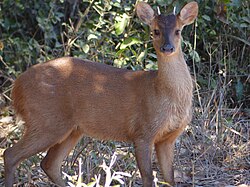| Red brocket | |
|---|---|
 | |
| Scientific classification | |
| Domain: | Eukaryota |
| Kingdom: | Animalia |
| Phylum: | Chordata |
| Class: | Mammalia |
| Order: | Artiodactyla |
| Family: | Cervidae |
| Subfamily: | Capreolinae |
| Genus: | Mazama |
| Species: | M. americana |
| Binomial name | |
| Mazama americana (Erxleben, 1777) | |
 | |
The red brocket (Mazama americana) is a species of brocket deer from forests in South America, ranging from northern Argentina to Colombia and the Guianas. [1] [2] It also occurs on the Caribbean island of Trinidad (it also occurred on the island of Tobago until very recent historical times, but has been extirpated there).



